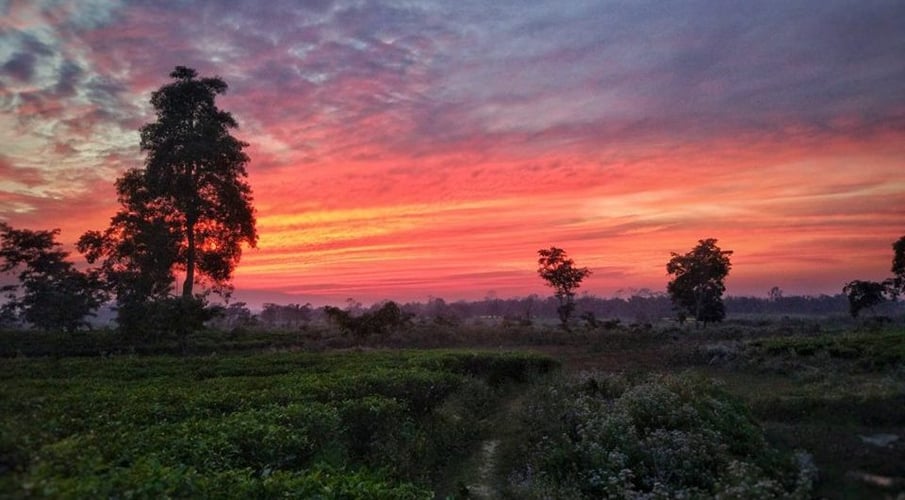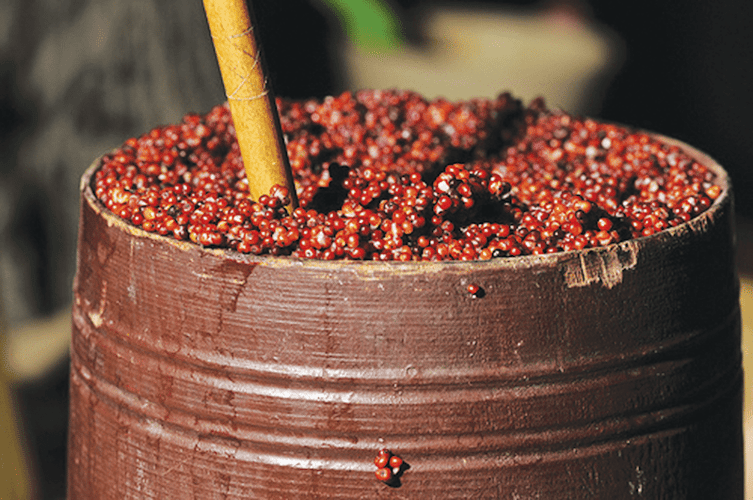Chasing the Food Trail in Assam and Meghalaya
https://commons.wikimedia.org/wiki/Category:Spices_of_India#/media/File:Four_colors_of_peppercorn.jpg
India’s North-Eastern sector folded in the lap of the Himalayas, has been bequeathed with vivid, painted locales harmonised with a glorious culture. The vast stretches of land carve out unruffled charm through eight states. Assam, ‘The Land of Blue Hills and Red River,’ and Meghalaya, ‘The Abode of the Clouds,’ are two such provinces dripping with tropical grandeur, ancient history, and succulent cuisine.
Assam is often regarded as the gateway to the northeastern states and is bordered by Bhutan and Bangladesh. Its adjoining state, Meghalaya, shares its western and southern boundaries with Bangladesh as well. Penetrable borders and a shared heritage have shaped a fusion of elements with neighbouring influences on lifestyle, customs, and food.
A Blended Diaspora: Assamese history can be traced to Vedic and Tantric literature such as the Mahabharata and Kalika Purana with mythological roots. After the collapse of several ancient kingdoms and dynasties, the legendary Ahom Kingdom took centrestage in medieval times and revolutionised the social map of the state for 600 years. The end of this epoch was marked by the Burmese invasion and victory in the 19th century. Ultimately, the Treaty of Yandabo, sent complete control of Assam under the British, with present-day Arunachal Pradesh, Meghalaya, Mizoram, and Nagaland comprising the Assam region. A confluence of Indo-Aryan, Austro-Asiatic, and Tibeto-Burman habitats over centuries, led to the current existing blend of culture and tradition.
Meghalaya’s hills have observed numerous layers of migration with tribes of Mongoloid and Tibetan descent. The Bodo community of Assam is closely related to the Garo tribe of Meghalaya. Little is known and recorded about the area’s history before the advent of the British. The latter was firmly rooted in the sub-continent and to combat threats of conflicts with Burma, built diplomatic relations with the local ruling tribes, particularly the Khasi community, signing a treaty in Nongkhlaw, in 1827, to create passages for simpler access to the Assamese plains. However, continued resistance from unwilling local chiefs provided the British a pretext for military action and eventually complete political control over the area, where Meghalaya was incorporated into Assam in 1835. The local tribes were allowed to preserve their traditional way of life with great autonomy, and this was retained even after India’s independence in 1947.
When Assamese was imposed as an official language in the entire state in 1960, a largely peaceful protest for self-rule gathered merit, and Meghalaya was granted full statehood in 1972.
Assam on a Platter
With its vibrant wraps of greenery, chains of hills, and colossal rivers, Assam’s fertile plains have birthed a union of various ethnic groups. The synthesis of these civilizations has led to a gloried culinary culture. It forms an interesting intersection of the cooking habits of preparing fresh vegetables and fish from the plains and fermenting meat as preferred in the hills - an effective method of preserving food, to enable the growth of probiotics which help in improving digestion, and boosting the immune system. Colleen Taylor Sen, a renowned gastronomic historian, points out in her book Feasts and Fasts: A History of Food in India, that Assamese cuisine is the only regional cuisine in India that has sustained the six tastes of ancient Hindu cuisine.
The two concepts of Tenga, or acidic, and Khar, or alkaline, exist in harmony to balance different food preparations. Fish and rice are the staple food items in Assam with most meals centred on these ingredients, and the food is mild in flavour with liberal use of ginger, garlic, chilli peppers, banana flower, leaves, and stems. Spices are used only to prepare meat dishes. Although one of the hottest chillies in the world, Bhut Jalokia, is native to Assam, it is rarely used in Assamese cuisine.
https://www.instagram.com/p/BDxwaYZwuw1/?igshid=MzRlODBiNWFlZA==
Local communities often breed their own livestock such as cows, goats, and hens, and often own fish ponds, vegetable gardens, and banana plantations, leading to a steady supply of organic food all through the year. Families also cultivate small tea gardens and sell the excess produce in the market.
Rice comprises an integral part of Assamese cuisine and Assam is home to several indigenous varieties of rice due to its fertile plains being washed by the Brahmaputra River, and varied rainfall patterns. Joha rice, with its short grains, snatches a prized position, due to its aroma and delicate taste. Black rice has also gained importance in the recent past with its health benefits coming to light. It was known as ‘purple or forbidden rice’ in ancient China, reserved only for the emperor. There are multiple types of black rice in Assam, but the thick grain of Upen in Western Assam is the most favoured variety, especially for porridge. Assam has three distinct rice growing seasons - sali or winter rice, ahu or autumn rice, and boro or summer rice. Sali cultivation is the most widely practised method.
The tastes of Assam are on full display in ‘Magh Bihu,’ essentially the festival of food, held in mid-January. It signals the end of the harvesting season and is a gastronomic delight with family and friends feasting together. Rice cakes such as Sunga Pitha, Til Pitha, varieties of rice beer, curd, sweets of coconut called Laru, and a special preparation called Mah-Karai, a roasted mixture of rice and black gram, and an assortment of meats, are prepared elaborately and consumed with great relish and celebration.
Khar: At the heart of Assamese cuisine is khar, both an ingredient and a dish. An alkaline preparation, it is a dark brown liquid made from the sun-dried peel of Bhim Kol, an indigenous seeded variety of banana found in Assam. The peels are burnt after which water is filtered through the ashes of the peels overnight. The outcome is a brown fluid with a sharp aroma. It can be made in large batches and stored for several months. In some regions of Assam, the stems and bark of papaya trees replace banana peels. During festivals, when bulk Khar containers are required, the bulbs of young bananas are cut into pieces and dried in the sun.
https://www.instagram.com/p/BqRTfPVngde/?igshid=MzRlODBiNWFlZA==
Khar is chiefly cooked with mushy vegetables such as gourds and spinach, raw papaya, banana stems, pulses, and even fish, transforming the flavour of the dish with a changed fragrant scent. Easy preparations such as Kharoli, made by adding a few drops of mustard oil to raw Khar, are frequently cooked. Another favourite is a Khar-based Rohu fish head dish with as intoxicating an aroma as a bite of the delectable dish.
Khar was a substitute for salt in primeval times, as it was difficult to procure with Assam being a landlocked state, far from the coast. Alkalinity is what distinguishes Assamese cuisine from the rest of India.
Masor Tenga: Ideal for a light summer palate Masor Tenga is a subtle, tangy fish curry. The Tenga or sourness is achieved through tomatoes, dried mangosteen, lemon, raw mango, fenugreek, mustard seeds, and elephant apple. Mas means fish. The dish has Bengali influences and is easy to prepare requiring minimum time. Although it is a quintessential summer dish, it can be eaten in winter too where wood apple is added instead of lemon as a souring agent. Paired with hot steaming rice it makes a flavoursome meal and helps in aiding digestion.
https://www.instagram.com/p/Btod0ltnzpk/?igshid=MzRlODBiNWFlZA==
Aloo Pitika: Essentially a side dish, Aloo Pitika is prepared by boiling or smoking potatoes with salt and mustard oil. It is often served with rice and dal and is considered comfort food for the Assamese. Locals add extra flavouring according to taste by throwing in chopped onions, ginger, coriander, and chillies. It was previously taken as a condiment like lemon and green chillies but the social media boom has exploded the popularity of the dish in recent years.
The history of aloo pitika is tough to trace but likely, it was introduced by farming families who used earthen hobs to cook food. It was prepared after the main meal where potatoes were tossed on the drying wood coal of the burning firewood. The result was a smoked potato with a hard coating.
https://www.instagram.com/p/B76BFien7Wu/?igshid=MzRlODBiNWFlZA==
Ou Tenga: A bulky, round, greenish-yellow fruit with a hard shell, elephant apple or Ou Tenga is characteristic of Assamese cuisine and is used both when ripe and raw. Its sourness is more pronounced when it is unripe. Although theoretically a fruit, it is largely treated as a vegetable in Assam. Ou Tenga is used as a souring agent and acts as an alternative for limes and tomatoes. Its stringy texture and sharp taste contrast it with other ingredients of acidity. It is classically added to dal or masor tenga, and vegetables, and is served over rice. Sweet and sour sauces and chutney are also prepared with this fruit by boiling the elephant apple and adding jaggery, oil, and cumin seeds.
https://www.instagram.com/p/Bkguti7g1QO/?igshid=MzRlODBiNWFlZA==
Ou Tenga came to be called elephant apple as it is a popular food for wild elephants, who are instrumental in dispersing the seeds of the tree. It is known for its curative medicinal properties, regulating blood sugar, treating nervousness, stomach upsets, and fatigue.
Pitha: Exceedingly popular, Pitha is a rice cake that can be prepared in countless ways using varied ingredients. A special variety of glutinous rice, or bora saul, is soaked, ground, and then roasted or fried over the fire and fashioned into small cubes, squares, or cylinders. The Pitha is mixed with different ingredients such as jaggery (Ghila Pitha), coconut (Narikol Pitha), and sesame seeds (Til Pitha). This popular sweet dish is prepared during festivals such as ‘Magh Bihu.’
https://www.instagram.com/p/CnYurUJLuoP/?igshid=MzRlODBiNWFlZA==
Mising Kitchen, Ganeshguri, in Guwahati, with its bamboo seating and traditional artefacts, and a home-like ambience, is a popular restaurant to try the Assamese thali. If little oil and spice are on one’s ‘cuisine agenda,’ then Taii Singpho, Silpukhuri, also in Guwahati, provides enormous king-sized thalis which include pork, chicken, and fish preparations.
Meghalaya’s Aromatic Assortment
The stately waterfalls forming crystal clear pools, cavernous caves, flourishing forests, and verdant vales bedecked with a rainbow of orchids, in Meghalaya’s tropical climate, make it an idyllic retreat and escape from the harsh city lights and noises.
The productive soil in the state has bountied an abundant plethora of crops such as potatoes, peppers, millet, and chillies. Wild fruits local to the state are popular and utilised to enhance flavours. Soh Shang, a tiny red or yellow succulent fruit rich in vitamins A, C, and E, is either eaten raw with a dash of salt or turned into pickles and jams and is even added to beverages. Similarly, Sohphie, a sweet and sour fruit particularly enjoyed by the Khasi tribe, is rich in vitamin C and antioxidants and is best savoured as a pickle. Distinct tastes and aromas due to local tribal influences have made Meghalaya’s cuisine markedly different from its Assamese neighbour.
Rice and meat, especially pork, form the fulcrum of the local diet and are integral to all three major tribes of the region, namely the Garo, Khasi, and Jaintia communities. Locally available vegetables, herbs, and spices are added to miscellaneous meat preparations and further peppered with the use of diverse ingredients such as soybean, bamboo shoot, leafy mustard, and sesame seeds. The process of cooking differs based on the accessibility of materials, climate, and culture. The Garo tribe tends to favour a generous amount of indigenous soda in their cooking, while the Jaintia community prefers mushrooms, or Tit Tung, and the Khasi palate relishes fermented fish and pork. Typically each household breeds two to three pigs with pigsties either beside or beneath the house, protecting the animals from natural temperamental elements.
Jadoh: A well-known dish of the Khasi tribe, Jadoh is an aromatic Meghalayan equivalent of biryani. Ja means rice and Doh means meat. It is primarily made with short-grain red rice or joha rice, and pork fat, with very little oil. The meat is cooked slowly with onions and an array of fragrant spices such as ginger, Lakadong turmeric, black pepper, and bay leaves. Lakadong turmeric is native to Meghalaya and is grown naturally in the fertile black alluvial soil without chemicals. It is known as the magic spice due to its unbelievably high curcumin content - a compound with anti-inflammatory properties and antioxidants believed to prevent heart disease and arthritis. The robustness of the spices fused with caramelised onions and the smokiness of the pork is a succulent, delightful dish. Jadoh can be prepared with other meats as well but pork remains the dominant choice. Locals also enjoy Jadoh snam, a delicacy cooked in pork or chicken blood lending a distinct metallic taste to the rice. It is a popular item on the menu of Khasi festivals such ‘Ka Shad Suk Mynsiem,’ a dance of thanks held in April with men and women dressed in traditional regalia, dancing to the sounds of drums and the flute.
https://www.instagram.com/p/COIXJw7lzeX/?igshid=MzRlODBiNWFlZA==
Dohkhileh: Typical Khasi fare, Dohkhileh is a chunky pork salad, consisting chiefly of pig brains and other organs of the animal in smaller quantities. Dohkhlieh means mixed meat and that is precisely how the community prepares it - by combining all the parts of a pig. Although preparations may vary, the traditional recipe is made from boiled pork, finely chopped onions, green chillies, ginger, and local seasoning. The salad is often topped with lettuce leaves, tomatoes, beans, coriander, and lemon. It is accompanied by a portion of bread. It is consumed almost at every meal as the native population believes it improves the rosiness of the skin.
https://www.instagram.com/p/BxH_fVaHaax/?igshid=MzRlODBiNWFlZA==
Pumaloi: A Khasi kitchen classic, Pumaloi is a rice cake made of special powdered rice which is soaked, crushed, shaped, and then steamed on medium heat, in a unique black terracotta pot called ‘Khiew Ranei.’ It is served with chutneys or stew and is consumed as an anytime-perfect meal, be it breakfast, lunch, or dinner. Pumaloi can also be stuffed with pork, chicken, or vegetables, and sometimes even grated coconut. Tourists often liken the taste to idlis prepared in South India.
https://www.instagram.com/p/B_H-PXGlKF8/?igshid=MzRlODBiNWFlZA==
Nakham Bitchi: A Garo household delicacy, Nakham Bitchi is a spicy, thick fish soup. It is prepared with a special sun-dried fish in boiling water, with copious amounts of chillies and pepper. Although it is normally consumed after a heavy meal, it is sometimes used as a palate cleanser. The tangy taste makes it particularly suitable for Meghalaya’s weather, specifically on chilly winter nights when the spicy soup works wonders to keep one warm.
https://www.instagram.com/p/COAw_orlNw0/?igshid=MzRlODBiNWFlZA==
Wak Tangsek Pura: Another Garo community favourite, Wak Tangsek Pura is prepared using pork and green vegetables with powdered rice and indigenous soda. Finely mashed rice and soda are the key elements giving the dish its distinctive flavour. Although the cooking method used is simple with elementary ingredients, the dish is a winning savoury recipe with minimal usage of spices allowing the authenticity of the ingredients to shine.
https://www.instagram.com/p/CNFyB8Bo4zA/?igshid=MzRlODBiNWFlZA==
Dakharang: Popular in the homes of the Jaintia people, Dakharang is smoked fish prepared as a curry, chutney, or salad. Dakha means fish and rang means dry, and it is often spiced with black sesame seeds, turmeric, salt, and garlic. The smokiness of the dish is offset with rice and whilst it is a simple recipe, it leaves a lasting aftertaste.
https://www.instagram.com/p/CiASC-UsUsK/?igshid=MzRlODBiNWFlZA==
Kyat: A treasured locally prepared alcoholic brew, Kyat, or rice beer, signifies celebration in the Meghalaya diaspora. Made naturally from fermented rice, the drink is a symbol of hospitality and is an integral part of various religious celebrations. The fermented rice is boiled in water and then embellished with local ingredients. Kyat is readily available in Meghalaya and often households will not let visitors leave without a tall glass of the refreshing drink.
https://www.instagram.com/reel/CWD8Y2ElXS1/?igshid=MzRlODBiNWFlZA==
Trattoria is often credited as the best restaurant offering Khasi food in Shillong. Jadoh, named after the beloved dish, is also a known haunt in Don Bosco Square, Laitumkhrah, which offers traditional fare at reasonable price.
The cuisines of Assam and Meghalaya differ in their use of spices where the former emphasises their use in abundance to enhance flavours and the latter focusses more on the prime ingredients and simpler seasonings. However, both states stick to healthy foods with a tilt toward sour and tart tastes. Most styles of cooking use mustard oil to prepare dishes. The resulting food is an exotic union of regional elements and fixings with foreign influences. Food is often the finest approach to understanding the nuances hidden in cultures. Sampling local fare often transports one to the reminiscence of certain aromas and sounds in kitchens. Exploring food in Assam and Meghalaya is a diverse explosion of flavour. Take a culinary expedition with Offbeat Tracks in Assam and Meghalaya to comprehend the history behind these striking homelands of beauty.



